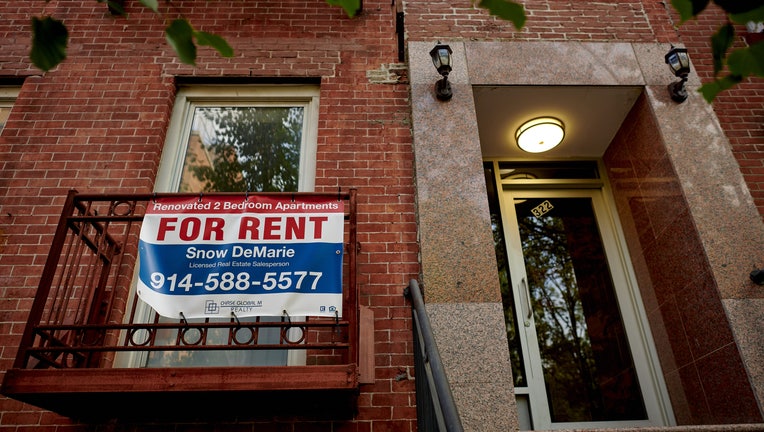Despite high rent, it’s still cheaper than buying a home – except in these cities

A "For Rent" sign outside an apartment building in the East Village neighborhood of New York, US, on Tuesday, July 12, 2022. Photographer: Gabby Jones/Bloomberg via Getty Images
Median rents in the 50 largest U.S. metropolitan areas climbed to a record $1,876 in June, but that’s still less than the monthly cost of buying a starter home in most cities, according to realtor.com.
In its June rental report, realtor.com said rental rates listed on their website were up 14.1% over the same time last year — they’ve hit record levels every month for the past 16 months.
Rent increases have slowed since they peaked in January at 17.3% more than the year before, but rent is 23.9% higher than it was in June 2020 and 27.6% higher than in June 2019. Rental rates for studio apartments have grown faster than 1- and 2-bedroom units.
Metros with the highest year-over-year rent increases:
- Miami (37.4%)
- Orlando (23.9%)
- Austin (19.6%)
- San Diego (19.1%)
- San Jose (18.5%)
- Nashville (18.4%)
- Charlotte (18.4%)
- Providence (23.8%)
- Boston (23.6%)
- New York (21.1%)
Metros with the lowest year-over-year rent increases:
- Minneapolis (3.3%)
- New Orleans (6.6%)
- Philadelphia (6.8%)
- Riverside (7.2%)
- Sacramento (7.3%)
- St. Louis (7.5%)
- Rochester (8.4%)
- Cincinnati (9.1%)
- Pittsburgh (9.4%)
- Detroit (9.6%)
Despite the soaring rent costs, in 38 of the 50 largest metros in America, it’s still cheaper to rent than to buy a starter home.
Seven months ago, only 24 markets were cheaper for renters. In some cities, buying a home costs over $2,000 a month more than renting.
RELATED: Selling a home: Front door color matters, Zillow data says
The average cost to buy a starter home across the 50 largest US metros was $2,437 a month in June, 29.9% more than the average listed rent. A year ago, the monthly cost to buy was $1,815, 10.4% more than rent.
Top 10 metros where it’s cheaper to buy than rent
- Pittsburgh, Penn.: median rent, $1,583; monthly buy cost, $1,061
- Birmingham-Hoover, Ala.: median rent, $1,278; monthly buy cost, $900
- St. Louis, Mo.-Ill.: median rent, $1,371; monthly buy cost, $1,087
- Cleveland-Elyria, Ohio: median rent, $1,432; monthly buy cost, $1,234
- Baltimore-Columbia-Towson, Md.: median rent, $1,820; monthly buy cost, $1,656
- Louisville-Jefferson County, Ky.-Ind.: median rent, $1,253; monthly buy cost, $1,189
- Virginia Beach-Norfolk-Newport News, Va.-N.C.: median rent, $1,581; monthly buy cost, $1,526
- Indianapolis-Carmel-Anderson, Ind.: median rent, $1,303; monthly buy cost, $1,266
- Cincinnati, Ohio-Ky.-Ind.: median rent, $1,499; monthly buy cost, $1,485
- Kansas City, Mo.-Kan.: median rent, $1,326; monthly buy cost, $1,313
Top 10 metros where it’s cheaper to rent than buy
- Austin-Round Rock, Texas: median rent, $1,864; monthly buy cost, $3,685
- San Francisco-Oakland-Hayward, Calif.: median rent, $3,171; monthly buy cost, $5,705
- Seattle-Tacoma-Bellevue, Wash.: median rent, $2,299; monthly buy cost, $4,100
- New York-Newark-Jersey City, N.Y.-N.J.-Penn.: median rent, $2,989; monthly buy cost, $5,081
- San Jose-Sunnyvale-Santa Clara, Calif.: median rent, $3,324; monthly buy cost, $5,499
- Portland-Vancouver-Hillsboro, Ore.-Wash.: median rent, $1,833; monthly buy cost, $2,961
- Los Angeles-Long Beach-Anaheim, Calif.: median rent, $3,051; monthly buy cost, $4,897
- Boston-Cambridge-Newton, Mass.-N.H.: median rent, $2,966; monthly buy cost, $4,664
- Houston-The Woodlands-Sugar Land, Texas: median rent, $1,450; monthly buy cost, $2,223
- Phoenix-Mesa-Scottsdale, Ariz.: median rent, $1,781; monthly buy cost, $2,709
What’s causing the housing slowdown?
Analysts say the biggest driver in the change is rising interest rates and the cost of financing a home: In January, the average 30-year fixed mortgage rate was 3.45%. In June, it was 5.52%.
Most economists expect the Federal Reserve to jack up its borrowing rate another half-to-three-quarters of a point when it meets next week. Fed policymakers have signaled that much higher interest rates may be needed to reign in stubborn, four-decade high inflation.
RELATED: Home that inspired 'The Conjuring' sells for more than $1.5M
The central bank already raised its benchmark rate by a half-point in May and another three-quarters of a point last month, the biggest single hike since 1994.
Home builder confidence is also down, according to the National Association of Home Builders. A recent survey showed that 13% of builders reported reducing home prices in the past month to boost sales.
RELATED: Confidence of US home builders plunges in July as rising costs slow sales
"Production bottlenecks, rising home building costs and high inflation are causing many builders to halt construction because the cost of land, construction, and financing exceeds the market value of the home," NAHB Chairman Jerry Konter, a home builder and developer from Savannah, Georgia, said in a statement.
The Associated Press and FOX’s Kelly Hayes contributed to this report.

